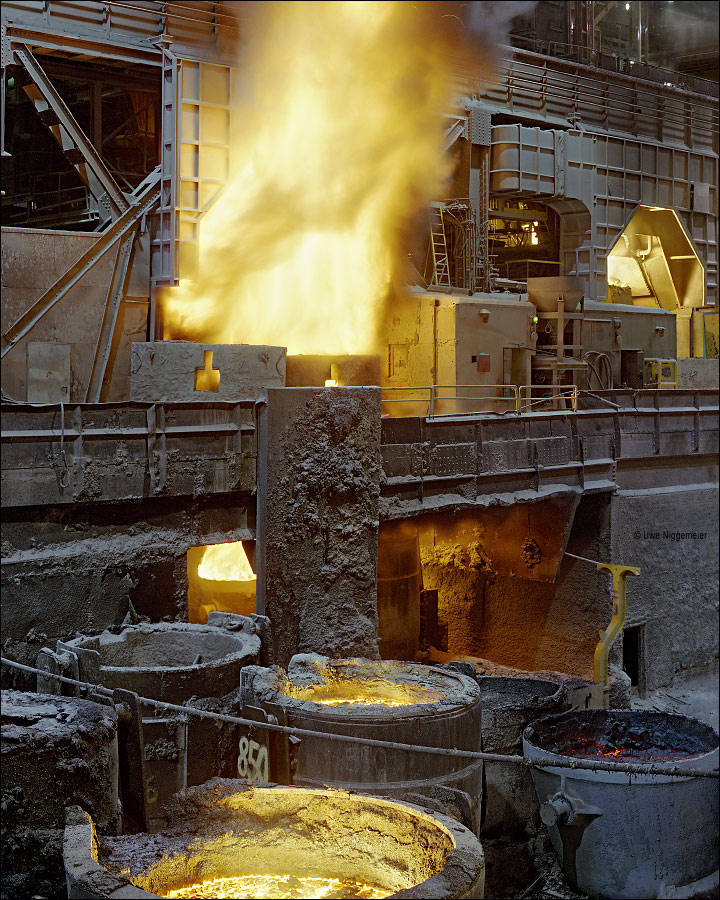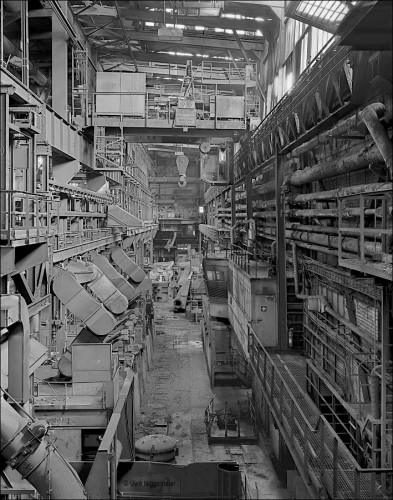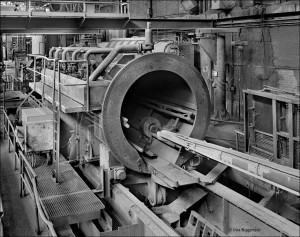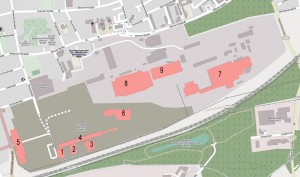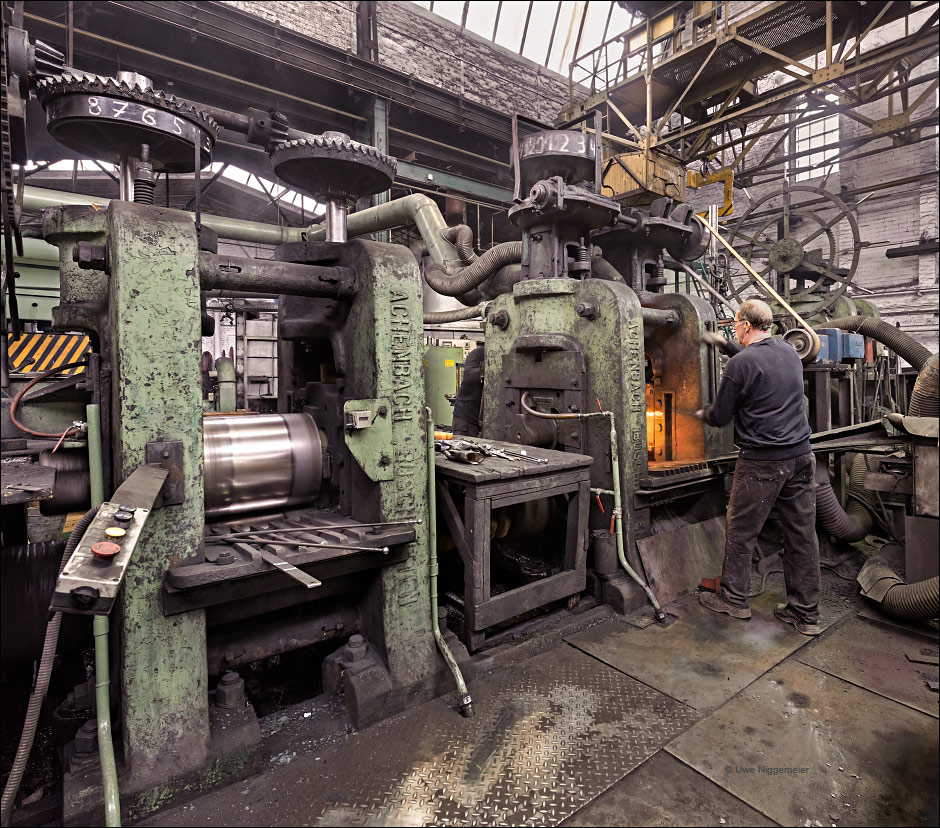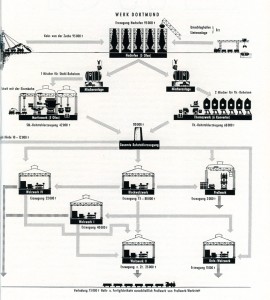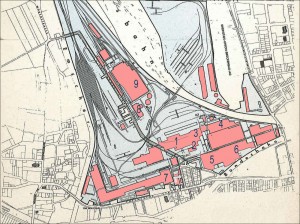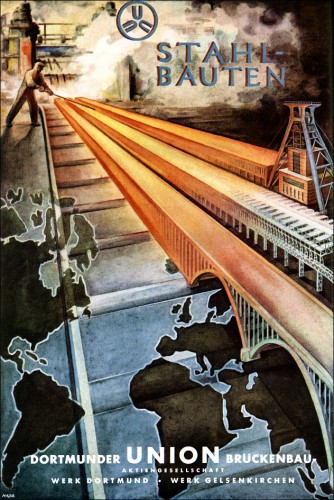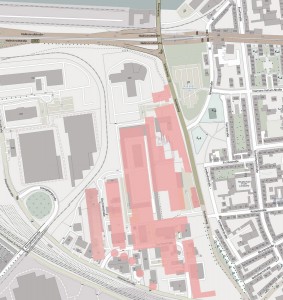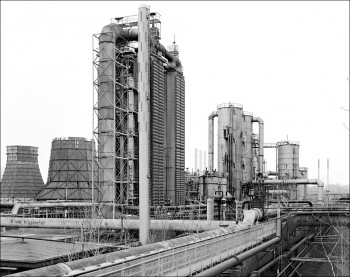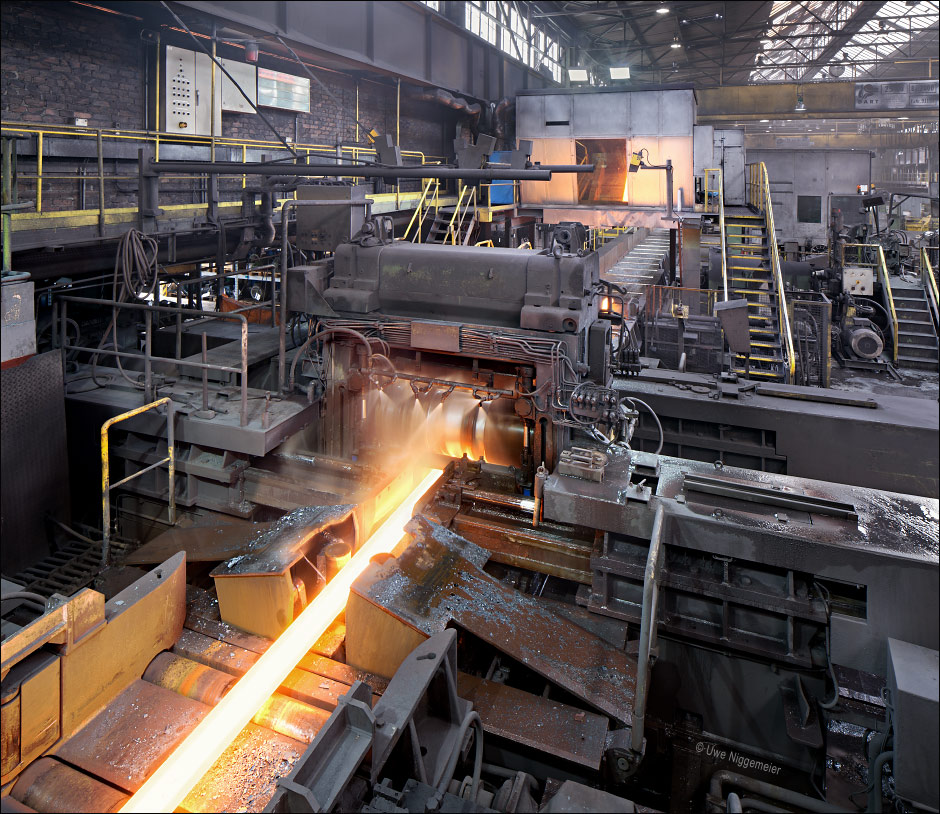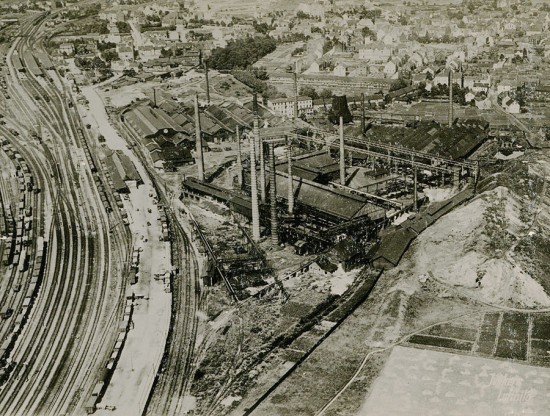According to a German newspaper the Finnish Outokumpu steel corporation declared yesterday that they will definitely close their stainless steel mill in Bochum, Germany they only just had bought from ThyssenKrupp in 2016.
Main reason are the high energy costs in Germany.
The mills includes an electric arc melt shop built in 1982 (the 145 ton UHP furnace is one of the largest in Germany) and the converter mill built by the Bochumer Verein in 1957.
This BOF shop is the oldest existing in Germany. It was converted into an AOD shop in 1972.
After GM recently announced the closure of it’s Bochum car assembly plant for 2016 this is another heavy blow for Bochum’s economy.
Images at stahlseite.de
Category Archives: Ruhr-East
A BOF Shop For Gelsenkirchen
50 years ago the Rheinstahl AG from Essen, Germany finally cancelled it’s plans to built a BOF shop, a continuous caster and a bar rolling mill at it’s foundry site in Gelsenkirchen.
The Schalker Gruben- und Hüttenverein was founded in 1872 and became Europe’s largest iron foundry after the second world war, employing more than 6000 people. The plans provided an investment of more than 300 Mio.German Marks and an initial capacity of 600.000 tons of steel per year. Though the ground (north of the foundry no.3, next to the Wannerstrasse) was already prepared the whole project was called off due to growing overcapacities on the steel market. So the Schalker Verein stayed an iron foundry with four blast furnaces, a pipe casting mill, two fittings-foundries and a foundry for large castings up to 40 tons a piece
The image shows the melt shop of the pipe casting mill where ductile iron pipes with a diameter up to 1,4 meter were casted. The shop included a 160 ton hot metal mixer and five 13 ton induction furnaces and was built in 1966. The hot metal was provided by the Schalker Verein blast furnaces and later came from Thyssen’s Duisburg Meiderich site (today: Landschaftspark Nord).
The foundry was sold to Thyssen in 1973.The last blast furnace was closed in 1982. The three remaining blast furnaces were demolished in-between April and September of 1983.
The last pipe was casted in 2004 (meanwhile the mill was sold to the French Pont a Mousson/Saint Gobain company). Most of the ground is a redevelopment site by now.
Some historic images at Daniel Hinze’s site.
1: Blast furnace no.1 (Hochofen 1)
2: Blast furnace no.2 (Hochofen 2)
3: Blast furnace no.4 (Hochofen 4)
4: Storage with highline (Möllerbunker)
5: Power station (Kraftzentrale)
6: Sinter plant (Sinteranlage)
7: Pipe foundry (Rohrgiesserei)
8: Fittings foundry no.1 ( Formstückgiesserei 1)
9: Foundry for large castings (Grossgusswerk)
The Smallest Hot Rolling Mill In Germany
The Idealspaten-Bredt company was founded in 1899 by Emil Eckardt under the name „Schaufel- und Spatenfabrik Eckardt & Co“ in Herdecke, Germany.
Built next to the railroad line from Hagen to Dortmund the new company was spezialized in the production of spades and shovels.The company’s speciality, until today, is the Idealspaten. A spade whose blade is hot rolled of one piece of steel.
In 1925 a new rolling mill was built which is still in use today.
In 1928 the company went bancrupt and changed it’s name to “Idealspaten- und Schaufelwalzwerke vorm. Eckardt & Co., G.m.b.H., Herdecke“.
In the 1930ies and during the second world war the rolling mill produced vast numbers of spades and shovels for the Reichsarbeitsdienst and the German Army. More than 500 people worked for the Idealspaten company.
In 1939 the „Teplitzer Eisenwerke, Schaufel- und Zeugwaren-Fabrik AG“, formerly owned by a Jewish family, in the Czech Republic was taken over.
In 1971 Idealspaten fusioned with its competitor from nearby Witten to form the “Idealspaten- und Schaufelwalzwerke A. Bredt GmbH & Co. KG”, the last industrial producer of spades and shovels in Germany. Further images
.
Heavy Rolling
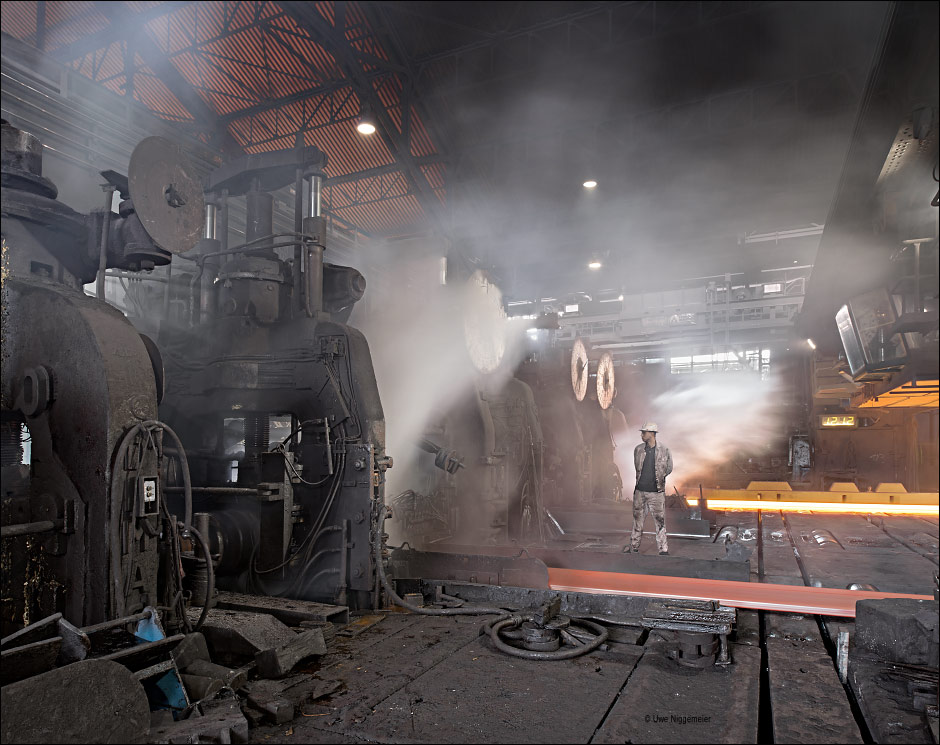
Hoesch Spundwand und Profile (HSP) is the last survivor of the once fully integrated Dortmunder Union steel mill.
The Union AG für Bergbau, Eisen- und Stahl-Industrie was founded in 1872 west of Dortmund in Germany.
In 1881 three blast furnaces were built.
After the Union became part of the Deutsch-Luxemburgische Bergwerks- und Hütten-AG in 1910 an extensive modernisation scheme brought a new Thomas converter melt shop an open hearth shop,a blooming mill and the heavy section mill, called rolling mill NO1, that is partly still in use today.
In 1926 the Union works became part of the Vereinigte Stahlwerke AG from Düsseldorf.
After this company was dismantled after the second world war the Union works joined the Hörder Verein , another steel company from Dortmund, to form the Dortmund Hörder Hüttenunion (DHHU).
In 1957 a continuous medium section rolling mill was erected now called rolling mill NO 2.
In November 1963 the last of the five Union blast furnaces and the Thomas converter steel mill were closed for good.
In 1966 the DHHU was taken over by the Hoesch Stahl AG from Dortmund. The division was called “Werk Union” from now on.
In 1981 the open hearth shop and the rolling mill NO2 were closed.
In 1992 Hoesch was bought by the Krupp company from Essen. Two years later the new subdivision Hoesch Spundwand und Profile was founded.
From 1999 on the remaining rolling mill was part of the ThyssenKrupp Stahl company to be sold to the Salzgitter Stahl company in 2000.
HSP is the only producer of sheet piles and heavy sections in Germany now.
Further images.
1. Heavy sections mill
2. Blooming mill
3. Former Thomas steel mill
4. Open hearth shop
5. Roll lathe plant
6. Forge
7. Medium sections mill
8. Boiler house
9. Repair shops
Dortmunder Union Brückenbau
Once one of the largest engineering companies in Europe (later Rheinstahl Union Brückenbau AG) whose steel bridges are still present everywhere in Germany and that built the Assuan dam in Egypt has nearly disappeared by now.
The workshop south of the Dortmund harbor was famous for it’s 276 meter long and 60 meter wide main hall that housed a bridge assembly line.
This famous structure built in 1898 was torn down in 1995.
Kokerei Hansa
Survivor
The Hoesch AG based in Dortmund once gave work to 64000 men and women, controlling dozens of subsidiaries. Few members of this steel empire have survived. One of them is the Hoesch Schwerter Profile GmbH.
The steel mill in Schwerte, Germany was founded by the Kissing & Schmöle company from nearby Menden in 1868 next to the brand new railroad line going from Hagen to Unna.
A melt shop and 5 rolling mills were built.
The Johanneshütte near Siegen, running two blast furnaces, was acquired in 1871 and supplied iron until 1914.
In 1891 the mill was expanded by an open hearth shop, a blooming mill and a wire mill.
In 1926 the steel plant became part of the Vereinigte Stahlwerke AG and was renamed Schwerter Profileisenwalzwerke AG in 1936.
After the war Schwerte became part of the Dortmund-Hörder Hüttenunion (DHHU).
The stamping mill was built in 1957 and from 1962 the new rolling mill no.7 replaced all older mills.
After the fusion of DHHU and Hoesch in 1966 Schwerte joined the Hoesch rolling mills in Hohenlimburg to form the Hoesch Werke Hohenlimburg Schwerte AG.
The takeover of Hoesch by Krupp in 1992 made the works part of Friedrich Krupp AG Hoesch-Krupp, and in 1999 of the ThyssenKrupp AG.
In 2005 the Calvi holding from Italy purchased the Schwerte plant, now called Hoesch Schwerter Profile GmbH, producing 70000 tons of special profiles per year and employing a staff of 530.
Further images.
Hoesch Phoenix Works, 1970ies
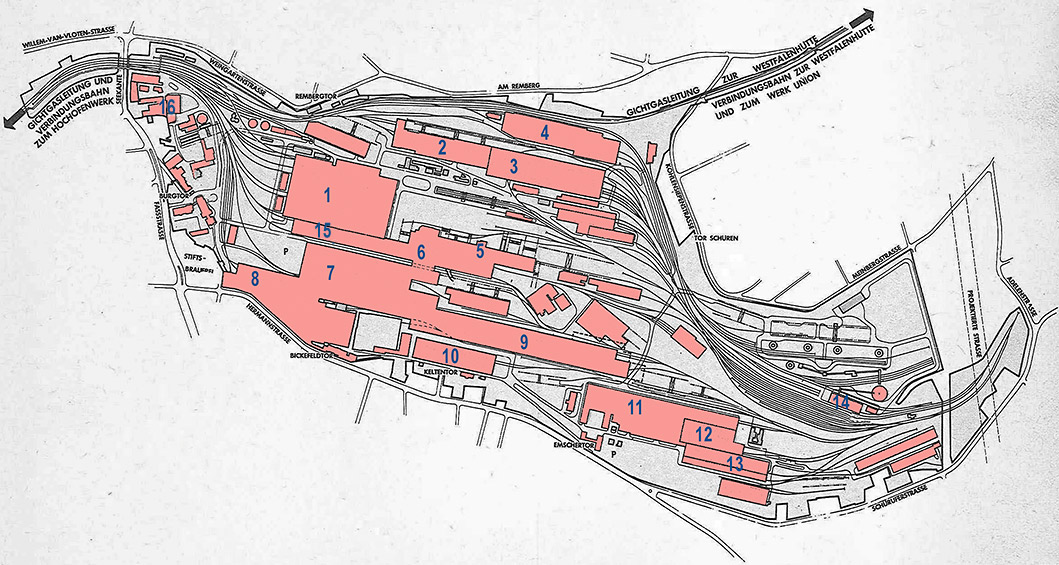 This plan shows the former Hermannshütte in Dortmund-Hörde, Germany, probably in the early 1970ies before the first continuous caster was built:
This plan shows the former Hermannshütte in Dortmund-Hörde, Germany, probably in the early 1970ies before the first continuous caster was built:
- BOF shop (Oxygenstahlwerk) closed 2001
- Open hearth shop IV ,former II (Siemens-Martin Stahlwerk IV, ehem. II) prob. closed in 1971
- Steel foundry (Stahlgiesserei) closed 1987
- Plate storage (Blechlagerhalle)
- Rolling mill 900 (900er Strasse)
- Blooming/slabbing mill (Blockbrammenstrasse) closed prob. 1985
- Heavy plate mill (Grobblechstrasse) closed 1982
- Finishing (Adjustage West)
- Finishing (Adjustage Ost)
- Roller lathe (Walzendreherei)
- Repair shop (Mechanische Werkstatt)
- Welding (Schweisserei)
- Forge (Pressbau)
- Slag mill (Schlackenmühle)
- Soaking pits (Tieföfen)
- Main storage (Zentrallager)
Today the area is transformed into a lake.
Some inside views.

